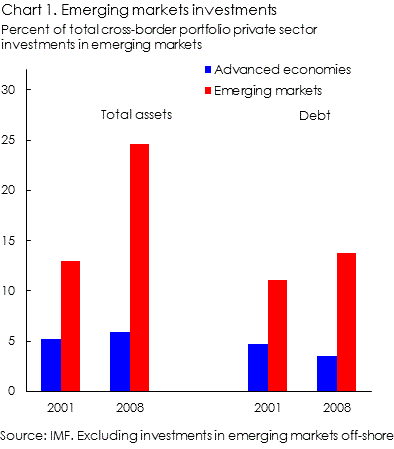South-south investments
8 February 2010
Ousmène Mandeng, Ashmore Investment Management
Emerging markets are increasingly seeking investments in other emerging markets. The latest IMF portfolio investment data (CPIS) show that emerging markets continue to allocate an increasing proportion of their cross-border portfolio investments to other emerging markets. This contrasts with persistent sluggish portfolio investments in emerging markets by advanced economies. The asymmetry in allocation behaviour seems to reveal significant differences in views about the international economy and where it is heading, namely emerging markets seem increasingly confident about themselves (Chart 1).
Emerging markets cross-border portfolio assets have grown 3 times between 2001 and 2008 compared with 2 times for advanced economies; but they have put 6 times more assets in emerging markets compared with 2½ times for advanced economies during the same period. This trend if sustained will provide a basis for increasing South-south investment integration. It is also likely to shift relative portfolio prices in favour of emerging markets
The portfolio allocation pattern of emerging markets shows that total cross-border assets allocated to emerging markets have grown significantly and have been large relative to most commonly used market benchmark indicators. Investments are driven predominantly by equities but allocation to debt securities has also shown a continued rise. Advanced economies have maintained a substantially higher proportion of their cross-border portfolio investments in other advanced economies. However, advanced economies are not homogenous. The U.S. has increased its cross- border allocation to emerging markets from 10 percent in 2001 to 13 percent in 2008; Japan, Germany and France have maintained their exposure to less than 3 percent in 2008.
Cross-border investment patterns differ significantly among emerging markets (Chart 2). Thailand holds about half of its cross-border portfolio assets in Korea making it one of the most important holders of Korean portfolio assets. Egypt holds 20 percent of its cross- border portfolio assets in Saudi Arabia. In contrast, Argentina and Colombia hold 87 percent and 74 percent of their cross-border portfolio assets in the U.S.
The average cross-border portfolio allocation to emerging markets differs significantly from the allocations of the official sector for reserve assets. The data show that the official sector maintains 0 percent of its reserve assets in emerging markets. The difference between official and non-official holdings rests in part on the specific purposes and necessary attributes of reserve assets. However, given that many central banks hold more reserves than needed for immediate reserve purposes, it may also reveal a behavioural bias.
Differences in portfolio investment directions between countries and groups of countries seem to indicate fundamental differences in investment behaviour and views about investment opportunities. The official sector lags behind in terms of investment directions with regard to both advanced economies and emerging markets. Assuming that central banks in emerging markets were to follow their countries’ portfolio investment patterns for debt securities, given about US$6 trillion of reserves are held by emerging markets central banks, this would correspond to an inflow into emerging markets debt securities of about US$800 billion. The recent spat between China and the U.S. may be a gentle reminder that official allocations can make a difference. For investors in both advanced economies and emerging markets securities, this may be the big- gest technical so far.

